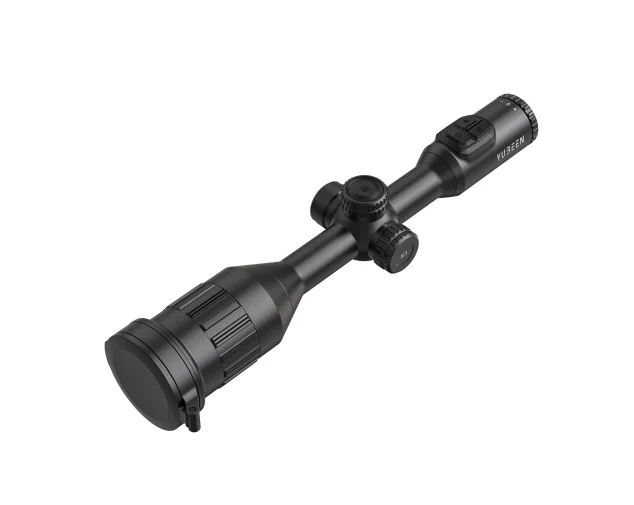The Essential Buyer’s Guide to Thermal Rifle Scopes

What Are Thermal Rifle Scopes?
Thermal imaging rifle scopes are high-tech tools made with the latest know-how. They’re built with care to catch heat signals. These signals are infrared rays that things give off. The scopes use special sensors. These sensors notice even the smallest changes in infrared light.
When heat is found, the scope’s smart system turns it into pictures you can see clearly. It uses clever math and tricks to make sure the images are sharp and true. Unlike normal scopes that need light, thermal imaging rifle scopes work great in dark or tricky spots.
How Thermal Imaging Works
Everything—big or tiny, alive or not—sends out heat as infrared rays. This is a simple science fact. Hotter things give off more rays. For example, a blazing campfire shoots out way more infrared light than a warm cup of cocoa. That’s because its bits move faster.
Thermal imaging rifle scopes grab these rays. Then, they turn them into images you can look at. This lets you spot animals, people, or stuff by their heat, even in darkness or fog.
Why Thermal Scopes Are Awesome Outdoors
Thermal imaging rifle scopes give big advantages for outdoor jobs:
Shines at Night: They work without any light, ideal for nighttime tasks.
Cuts Through Weather: They see past rain, fog, or thick plants, keeping targets in sight.
Picks Out Targets: They let you tell animals or people apart by their heat shapes.
Keeps You Safe: They warn you early in dangerous, hard-to-see places.
What to Check When Picking Thermal Scopes
Image Clearness and Sensor Strength
How clear the picture is depends on the sensor’s power. Scopes with 384×288 or 640×512 pixel sensors make sharp, detailed images. The best ones, with 12μm pixel pitch, catch tiny heat changes for really crisp pictures.
Why Clearness Counts
Sharp images let you see little details from far off. This is super useful for hunting or guarding, where knowing exactly what’s out there matters a lot.
Reach and Zoom Strength
Spotting Distance: This is how far the scope can see a heat signal. Top-notch scopes, like YUBEEN models, reach up to 3,100 meters. Most spot between 300 and 2,600 meters, based on how good they are.
Zoom Choices: Zoom makes far things look near. Adjustable zoom, like 1-8x digital, works for close or distant targets. Bigger lenses (like 35mm or 50mm) grab more heat for better reach but make the scope heavier.
View Width (FOV): A wider view lets you check more ground. It’s great for tight spots or fast searches. Big lenses give a broader view but add weight.
Steady Screen
A 50Hz refresh rate keeps pictures smooth. This helps when following quick targets, like deer sprinting or people moving fast. Faster rates give smoother images but use up the battery quicker. Choose what fits your job—hunting may need less than speedy security tasks.
Strength and Weather Proofing
Scopes must handle tough use, like strong gun kicks or bad weather. Look for:
Kick Resistance: A 6,000 Joules rating or more suits big guns (like .375 H&H). Army-grade scopes (MIL-STD-810) handle up to 9,000 Joules.
Weather Protection: An IP67 rating means the scope blocks dust, stays waterproof, and works in super cold or hot weather (-30°C to 55°C).
Solid Build: Tough materials keep the scope going in rough places, like wet woods or dry deserts.
Battery Power
Good battery life is key for long hunts or missions. Pick scopes with 7-10 hours of use. Rechargeable batteries (like 18650) or extra power packs help a lot. Sleep modes save juice when you’re not using the scope. For instance, the YUBEEN Krypton2 runs up to 11 hours with a backpack battery.
Bonus Features
Distance Finder (LRF): Built-in LRFs, like on the YUBEEN Thermion 2 LRF XL60, measure how far targets are. This helps make exact shots, especially from far away.
Aim Marks: At least six aim mark styles in different colors help you aim in all kinds of light or weather.
Recording: Video or photo saving, like on the ATN ThOR LTV, lets you keep clips for proof or fun.
Phone Links: Apps like Burris Connect or SIG’s BDX 2.0 tie the scope to your phone for info or shooting math.
Why YUBEEN Is Special

YUBEEN thermal imaging rifle scopes mix high tech with easy use:
Great Sensors: Uncooled microbolometer arrays with <18mK NETD catch small heat shifts for clear pictures.
Clear Screens: OLED displays with 1024×768 resolution give bright images and different viewing styles.
Far Reach: Some models see heat signals past 3,100 meters, great for distant targets.
Strong Build: Small, shock-proof designs with shake-proof recording stand up to tough conditions.
Where to Use Thermal Scopes
Hunting and Animal Watching
Thermal imaging rifle scopes change night hunting and wildlife watching. They spot warm creatures, like hogs or coyotes, in total darkness by catching their body heat. This beats normal scopes, which don’t work without light.
Hunter Perks
Sharp sensors (384×288 or 640×512) let you know what animal you’re seeing from far off. Switchable screen modes work in rain, fog, or clear nights.
Watching Without Bothering
Long reach (up to 2,600 meters) lets you watch animals without spooking them. This keeps their home peaceful.
Guarding and Tactical Jobs
Thermal scopes are key for protecting places or running special missions when regular cameras fail.
Catching Trespassers
They see people in no-light spots. Some models auto-follow heat signals for fast warnings.
Tactical Perks
Soldiers and cops use thermal scopes to check dangers quickly and save mission clips for later.
Saving People
Rescue teams use thermal imaging rifle scopes to find folks in hard places, like dense woods or broken buildings.
Finding Folks
Scopes with <18mK NETD spot human heat through junk or plants. This makes finding survivors easier.
Moving Fast
Quick scanning raises the chance of winning in urgent missions. It saves time and lives.
Smart Buying Tips
Features for Your Money
Top-Tier ($4,000-$10,000): YUBEEN Thermion 2 XP50 or Armasight Contractor gives great sensors, far reach, and extras like shooting math tools.
Mid-Level ($2,000-$4,000): ATN ThOR LT 320 or AGM Rattler TS35-384 offer good quality for less money.
Starter ($600-$2,000): RIX STORM S2 (256×192 resolution) suits new users with tight budgets.
Choosing for Your Job
Hunters: Pick clear pictures and multiple aim settings for different guns or distances.
Guards: Choose far spotting and strong builds for all-night watches.
Rescuers: Go for high sensitivity and wide views for quick searches.
Protection and Help
Aim for a 24-month warranty to cover fixes. Friendly support makes repairs simple. Fancy scopes need good protection plans to stay top-notch.
Best Picks by Job
Night Hunting (Hogs/Coyotes): YUBEEN Thermion 2 XP50 ($4,000-$6,000) for super clearness or ATN ThOR LT 320 ($1,500-$2,500) for budget hunters.
Guarding: Armasight Contractor 640 ($4,000-$6,000) for tough builds and tactical tools.
Rescue: SIG ECHO SV50-LRF ($5,000-$6,000) with distance finders and sensors for fast people-finding.
Newbies: RIX STORM S2 ($799-$1,099) for cheap, trusty starters.
Caring for Your Scope
Lens Cleaning: Use a soft cloth and lens cleaner to keep pictures sharp.
Safe Storage: Keep in a dry, cool spot to guard the tech inside.
Battery Care: Use sleep modes or bring extra batteries (like 18650) for long outings.
Law Stuff
Check local rules before buying. Thermal scopes are fine for hunting in places like Texas (like for wild pigs), but some spots, like California, have tight laws on night gear. Always ask local officials.
FAQ
Q1: Can thermal scopes see through walls?
No. They only catch heat on outside surfaces, not inside buildings.
Q2: How long do batteries hold up?
Most run 4+ hours. Some, like YUBEEN models, use extra power packs for more time.
Q3: Do they handle bad weather?
Yes. IP67-rated scopes block water, dust, and crazy hot or cold.

